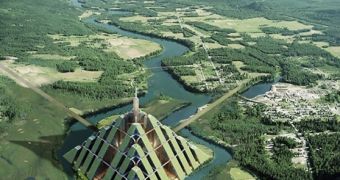Researchers from Timelink – an environmental design company based in Dubai – have come up with the idea of building these carbon-free cities in order to accommodate people on a surface that covers about 10% of the area they would otherwise need.
The term "ziggurat," which comes from the Akkadian language and means "to build on a raised area," defines a temple tower shaped like a step pyramid built some 5 millennia ago in Mesopotamia by Sumerians, Assyrians and Babylonians. Today, its sense may be altered as Timelink develops its own ecological glass-skinned version.
The 1.200 m tall building is supposed to cover 2.3 square km at its base and to be able to house 1 million people. It should also be self-sufficient in terms of food or energy. As Ridas Matonis, managing director of Timelinks, told World Architecture News, "Ziggurat communities can be almost totally self-sufficient energy-wise. Apart from using Steam power in the building we will also employ wind turbine technology to harness natural energy resources."
This city would be great for the planet, as it saves a lot of space that can be used for leisure pursuits or for agriculture. There is no need for cars inside, as transportation is done by means of a 360 degree network transited by elevators. Security of the complex is provided by biometrics, which allows door opening based on facial recognition.
As soon as Martijn Kramer, managing director of The International Institute for the Urban Environment stated that the Ziggurat project was technologically viable, people over at Timelinks rushed to patent their technology and designs, while applying to the UE for a grant for technical projects. The only issue that remains to be addressed is whether people would feel comfortable living in such buildings.
The official unveiling of the project is set for a month from now, October 6-9, during the Cityscape Dubai event, where a handful of European professors will explain that the Ziggurat is not meant to be a solitaire structure, but part of a greater architectural plan.

 14 DAY TRIAL //
14 DAY TRIAL //